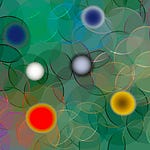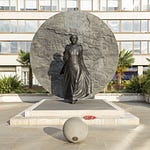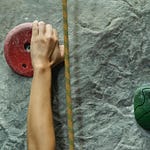Pain and the Brain
Last week, we looked at what we can do to nourish and soothe our physical body (annamayakosha) to help relieve or reduce pain. This week, we’ll explore how the manomayakosha (mental body) and the vijynanamayakosha (wisdom body) contribute to us experiencing physical pain. Next week, I’m planning to look at how breath, energy and spiritual connection can help us to manage pain.
As we look at pain from the mental perspective it’s important to note that pain is both physical and emotional. This is a point of view shared by pain scientists, particularly in the case of chronic pain.
“…we start with research on the neurobiology of pain and emotions because doing so underscores our view that the brain generates and organizes psychological and social experience and is the organ most relevant to persistent pain.”
The Field and the Knower of the Field
To recap on the philosophy we learned in last week’s article, pain is felt in the field of inner experience (known as the koshas, or panchamayakosha) which is part of prakriti the whole field of manifest reality. Our consciousness (atman) is part of purusha (the Consciousness that resides within all beings). Consciousness is not: matter, emotion, sensation or thought; it is the witness to these phenomena that lie within the field of prakriti. Consciousness (in the yoga worldview) is eternal, unchanging and untouched by whatever it observes.
When we view the field of our mental experience from atman (our unchanging witness consciousness) we are able to break our identification with the thoughts and emotions that arise within our manomayakosha (the mental body). We realise we are not our thoughts. In this way, we gain a sense of mastery over our thoughts. We can draw upon the vijyanamayakosha (wisdom body) to decide whether our thoughts are helpful or whether they are detrimental to our wellbeing. Using our wisdom and awareness (atman) we can choose to replace unhelpful thoughts with more supportive and nurturing thoughts. Pain scientists now recommend a therapy for pain called CBT (Cognitive Behavioural Therapy) to do just this.
Becoming a Witness to Our Thoughts
The thoughts that pervade our manomayakosha (which is sometimes translated as the lower mind) are not profound. Generally, they are repetitive and mundane. These thoughts fall into certain categories such as judging, comparing, planning, admonishing, remembering and worrying. Much of this rumination is going on just underneath the surface of our awareness.
It’s only when we stop and sit still that we notice what is really going on in our minds. It can be quite disconcerting or disappointing to witness our thoughts. It is no wonder so many people give up meditation before they have established a regular practice! We pick up many of these habits of thinking from our early caregivers, from our schooling, from our workplace, from our peers and from adverts and other forms of media programming. The voice in your head is most often not even your voice!
Meditation as a Cleansing Process
Sitting with our thoughts is challenging. Yet it becomes easier when we realise that this is the whole point of our meditation practice, we are meant to witness our thoughts. Observing and acknowledging our thoughts (however out of proportion, boring, unpalatable or downright mean they are) gives us freedom from those thoughts. As we bear witness to our thoughts we come to realise we are not the thoughts themselves, we are the observer of the thoughts. When we make the distinction between prakriti and purusha we reach an important milestone in our yoga practice.
Feeling Emotions in the Physical Body
When we feel unable to be with unwanted thoughts, they have the potential to create detrimental effects within the layers of our being (including the physical layer) annamaykosha. Again science is starting to recognise the effect of mental and emotional pain on the physical body. They call this process somatisation.
“…patients who somatize are reluctant or unable to acknowledge psychological or emotional problems, and their somatizing represents an alternative pathway to communicating their difficulties.”
Mind-Body Medicine
Dr John Sarno, an American rehabilitation physician who specialised in treating pain using mind-body techniques, recognised that in many cases chronic pain was related to the suppression of emotions. He noticed that people who experience chronic pain are often accommodating and uncomplaining. He referred to such people affectionately as “goodists”. Sarno viewed chronic pain as the body’s physical expression of unexpressed emotional rage.
When we begin to meditate and actively witness the contents of the manomayakosha, we might see a lot of rage, indignation, frustration, annoyance, judgement and anger. This is absolutely normal and it doesn’t mean you are a bad person! There is a perception that people who meditate have only peaceful and beautiful thoughts floating through their minds (if they have any thoughts at all that is). This perception is completely and utterly wrong.
In fact, it is both usual and rather useful, to witness a whirlwind of relentless irritating, critical and judgemental thoughts in your mind as you meditate. This is just perfect because when we see the rage, irritation and anger that lies within us, we automatically instigate a process of questioning it. Acknowledging and questioning help us to clear these feelings out. We start to recognise that many of our thoughts are quite irrational or at the very least not helpful to our mental wellbeing. As we witness our thoughts, without believing we are our thoughts, we can begin to exercise some discernment around what we are thinking and feeling.
Beware, the Spiritual Bypass
If you are new to meditation, and you find it difficult to access feelings of annoyance, judgement, rage or anxiety I would not view this as a sign of spiritual maturity or wellbeing. You may simply not feel safe witnessing negative thoughts and feelings, they might feel too overwhelming for you. In this case, it could be really helpful to seek the support of a counsellor or therapist. When we suppress our darker thoughts and feelings using our spiritual practice, it is known as “spiritual bypassing”.
The late John Welwood, an American psychologist, described spiritual bypassing as: “our tendency to use spiritual ideas and practices to sidestep or avoid facing unresolved emotional issues, psychological wounds, and unfinished developmental tasks.” He coined this term after noticing many people in the Buddhist community including himself, remained wounded despite their spiritual practices.
When it comes to mental and physical health, a multidisciplinary approach is ideal. Addressing all our health needs on our own, or taking only a spiritual approach is not ideal. Working with a variety of people with different perspectives and training can help us to better understand the whole of our being. Throughout our healing journey, we might see a counsellor, an osteopath, a nutritionist, a healer, a doctor and a yoga therapist to get a truly holistic view of how to manage and relieve pain.
Entertain the Crowd of Sorrows!
So instead of burying them, really celebrate finding those ugly, mean and vicious thoughts circling around in your mind! Remember our thoughts are not us, they are more often ideas we unconsciously picked up from other people. Welcome them in, as Rumi would say, and let them tell their story so you gain a deeper understanding of, and compassion for, yourself. The manomayakosha is linked to a structure of the mind called the ahamkara, which means the I-shape or the I-maker, similar to the concept of the ego in Western psychology. The ahamkara is there to protect our interests and identity and it will sometimes make irrational and unwise choices in order to defend us. When we do not question the ahamkara using our wisdom, the vijynanamayakosha, (which knows we are all one, interconnected whole) we unwittingly allow our ego to rule us.
The Physical Manifestation of Emotional Rage
It is possibly no coincidence that chronic pain conditions are usually inflammatory conditions. Sarno put forward the idea that unexpressed rage manifests as long term physical tension in the muscles and fascia. This habitual tension decreases oxygen flow to the tissues in the tense area. The body alerts us to this problem by sending pain signals to the brain. As we sense the pain, we worry, limit our movement and “guard” against the pain. This causes more tension and pain. Below, in a review of pain research the authors describe the difference between pain due to physical disease process, and myofascial pain, that is, pain with a possible mental root cause.
Some types of pain are tied to disease processes in specific tissues, including joint degeneration (osteoarthritis), inflammation (e.g., rheumatoid arthritis, inflammatory bowel disease), tumor growth (cancer pain), damaged nerves (neuropathic pain), or tissue anoxia (sickle cell disease). There also is a heterogeneous group of pain problems that have traditionally been classified according to location, such as low back, neck, head, abdomen, pelvis, and chest. The latter includes pain presentations that are part of broader multi-symptom syndromes, such as fibromyalgia or irritable bowel syndrome.
These latter syndromes and types of pain are particularly vexing because clinical and laboratory studies do not reliably indicate abnormalities in the peripheral tissue sites where patients experience pain.
Pain is Not Logical
Pain is anything but logical. Above we hear of doctors not being able to find abnormalities in the tissues where patients are experiencing pain. The excerpt below, comes from one of many papers which explore the vast amount of evidence that shows that many people do not experience pain (in this instance lower back pain - LBP), even though their MRI scans show all sorts of “problems” with their spine.
Imaging findings, such as disk degeneration, facet arthropathy, and disk herniations, have been attributed as causative factors for LBP; however, these structural abnormalities are present in a large proportion of asymptomatic individuals and the incidence of these findings increases with age.[5,6,7,8]
MRI is highly sensitive in detecting degenerative changes in the spine, however, several studies have shown degenerative changes to have no association with low back pain.[9,10,11]The Use of Imaging in Management of Patients with Low Back Pain
Dinesh Rao, Gaelyn Scuderi,1 Chris Scuderi,2 Reetu Grewal,2 and Sukhwinder JS Sandhu
J Clin Imaging Sci. 2018; 8: 30.Published online 2018 Aug 24. doi: 10.4103/jcis.JCIS_16_18
Being Kind to Ourselves
Whether we know the reason for our pain or not, we will benefit from witnessing the semi-conscious ruminations in our meditation practice. When we find ways of being mentally kinder (ahimsa) to ourselves and others, our whole system can find more peace. As our mental rumination becomes less emotionally charged, we create the conditions to release deeper layers of tension that we hold in our muscles and fascia. As mentioned, this can be a multidisciplinary process for some, although it may be straightforward for others. Certainly, if you are working with past trauma or if your thoughts and feelings are very uncomfortable to bear with, it is wise to seek professional guidance and support.
The Body is Wired to Find Balance and Heal
The practice of witnessing our thoughts and feelings is best viewed as a continuing process of cleansing and renewal. It’s akin to brushing our teeth and flossing every day. In life, we will inevitably face disappointments, difficulties, tragedy and injustice. Similarly, our tissues are likely to degenerate somewhat due to accidents, ailments or “wear and tear”. We might experience flare-ups in our body or mind for all these reasons and more. However, our bodies and minds have a huge capacity to heal if we give ourselves the right conditions to do just that. Yoga offers a wide range of supportive practices such as reflection, meditation, breathing, relaxation, mindful movement and a kind attitude towards ourselves. Making yoga practice a part of your life offers a safe and appropriate way of meeting the perplexing puzzle of chronic pain and creating lifelong holistic health and wellbeing.
Dear Yoga Student,
Just a short note this week to let you know that my Yoga for Back Care Course is now open for registration. It’s a hybrid course, which means it’s composed of both in-person and online classes. There are also home practice videos and lessons for you to access in between classes. If you’d really like to learn to reduce or relieve your back pain, this is the course for you. It’s a really comprehensive guide for anyone experiencing back pain, whether you are new to yoga or not.
£265 per person(if paid by bank transfer (email me); or £285 if paid online.
Find out about the Holistic Yoga for Back Care Course Here
There are still two rooms (twin or double) available on the Tilton House Retreat Early May Bank Holiday Retreat, so if you’d like to immerse yourself in relaxing, nurturing, therapeutic yoga and sound for four days over the early May Bank holiday then it’s time to book now.
£585 per person
Find out more about the Yoga and Sound Bank Holiday Retreat Here
The Monday 1:30-3pm in-person Holisitic Somatics course is ready for booking just simply book the classes you want to come to.
I’m away in Italy for the next week, then I’m on my first module of the Yoga Therapy Diploma. So be prepared for some gaps in the schedule in second half of April to early May.
I look forward to seeing you in class soon!
With love and good wishes,
Julia xx













Attending to the Messages of Pain: Part 2